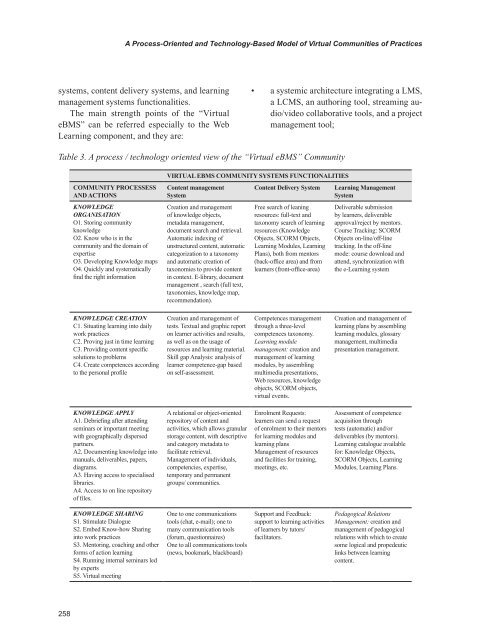Web-based Learning Solutions for Communities of Practice
Web-based Learning Solutions for Communities of Practice
Web-based Learning Solutions for Communities of Practice
You also want an ePaper? Increase the reach of your titles
YUMPU automatically turns print PDFs into web optimized ePapers that Google loves.
258<br />
A Process-Oriented and Technology-Based Model <strong>of</strong> Virtual <strong>Communities</strong> <strong>of</strong> <strong>Practice</strong>s<br />
systems, content delivery systems, and learning<br />
management systems functionalities.<br />
The main strength points <strong>of</strong> the “Virtual<br />
eBMS” can be referred especially to the <strong>Web</strong><br />
<strong>Learning</strong> component, and they are:<br />
• a systemic architecture integrating a LMS,<br />
a LCMS, an authoring tool, streaming audio/video<br />
collaborative tools, and a project<br />
management tool;<br />
Table 3. A process / technology oriented view <strong>of</strong> the “Virtual eBMS” Community<br />
COMMUNITY PROCESSESS<br />
AND ACTIONS<br />
KNOWLEDGE<br />
ORGANISATION<br />
O1. Storing community<br />
knowledge<br />
O2. Know who is in the<br />
community and the domain <strong>of</strong><br />
expertise<br />
O3. Developing Knowledge maps<br />
O4. Quickly and systematically<br />
find the right in<strong>for</strong>mation<br />
KNOWLEDGE CREATION<br />
C1. Situating learning into daily<br />
work practices<br />
C2. Proving just in time learning<br />
C3. Providing content specific<br />
solutions to problems<br />
C4. Create competences according<br />
to the personal pr<strong>of</strong>ile<br />
KNOWLEDGE APPLY<br />
A1. Debriefing after attending<br />
seminars or important meeting<br />
with geographically dispersed<br />
partners.<br />
A2. Documenting knowledge into<br />
manuals, deliverables, papers,<br />
diagrams.<br />
A3. Having access to specialised<br />
libraries.<br />
A4. Access to on line repository<br />
<strong>of</strong> files.<br />
KNOWLEDGE SHARING<br />
S1. Stimulate Dialogue<br />
S2. Embed Know-how Sharing<br />
into work practices<br />
S3. Mentoring, coaching and other<br />
<strong>for</strong>ms <strong>of</strong> action learning<br />
S4. Running internal seminars led<br />
by experts<br />
S5. Virtual meeting<br />
VIRTUAL EBMS COMMUNITY SYSTEMS FUNCTIONALITIES<br />
Content management<br />
System<br />
Creation and management<br />
<strong>of</strong> knowledge objects,<br />
metadata management,<br />
document search and retrieval.<br />
Automatic indexing <strong>of</strong><br />
unstructured content, automatic<br />
categorization to a taxonomy<br />
and automatic creation <strong>of</strong><br />
taxonomies to provide content<br />
in context. E-library, document<br />
management , search (full text,<br />
taxonomies, knowledge map,<br />
recommendation).<br />
Creation and management <strong>of</strong><br />
tests. Textual and graphic report<br />
on learner activities and results,<br />
as well as on the usage <strong>of</strong><br />
resources and learning material.<br />
Skill gap Analysis: analysis <strong>of</strong><br />
learner competence-gap <strong>based</strong><br />
on self-assessment.<br />
A relational or object-oriented<br />
repository <strong>of</strong> content and<br />
activities, which allows granular<br />
storage content, with descriptive<br />
and category metadata to<br />
facilitate retrieval.<br />
Management <strong>of</strong> individuals,<br />
competencies, expertise,<br />
temporary and permanent<br />
groups/ communities.<br />
One to one communications<br />
tools (chat, e-mail); one to<br />
many communication tools<br />
(<strong>for</strong>um, questionnaires)<br />
One to all communications tools<br />
(news, bookmark, blackboard)<br />
Content Delivery System <strong>Learning</strong> Management<br />
System<br />
Free search <strong>of</strong> leaning<br />
resources: full-text and<br />
taxonomy search <strong>of</strong> learning<br />
resources (Knowledge<br />
Objects, SCORM Objects,<br />
<strong>Learning</strong> Modules, <strong>Learning</strong><br />
Plans), both from mentors<br />
(back-<strong>of</strong>fice area) and from<br />
learners (front-<strong>of</strong>fice-area)<br />
Competences management<br />
through a three-level<br />
competences taxonomy.<br />
<strong>Learning</strong> module<br />
management: creation and<br />
management <strong>of</strong> learning<br />
modules, by assembling<br />
multimedia presentations,<br />
<strong>Web</strong> resources, knowledge<br />
objects, SCORM objects,<br />
virtual events.<br />
Enrolment Requests:<br />
learners can send a request<br />
<strong>of</strong> enrolment to their mentors<br />
<strong>for</strong> learning modules and<br />
learning plans<br />
Management <strong>of</strong> resources<br />
and facilities <strong>for</strong> training,<br />
meetings, etc.<br />
Support and Feedback:<br />
support to learning activities<br />
<strong>of</strong> learners by tutors/<br />
facilitators.<br />
Deliverable submission<br />
by learners, deliverable<br />
approval/reject by mentors.<br />
Course Tracking: SCORM<br />
Objects on-line/<strong>of</strong>f-line<br />
tracking. In the <strong>of</strong>f-line<br />
mode: course download and<br />
attend, synchronization with<br />
the e-<strong>Learning</strong> system<br />
Creation and management <strong>of</strong><br />
learning plans by assembling<br />
learning modules, glossary<br />
management, multimedia<br />
presentation management.<br />
Assessment <strong>of</strong> competence<br />
acquisition through<br />
tests (automatic) and/or<br />
deliverables (by mentors).<br />
<strong>Learning</strong> catalogue available<br />
<strong>for</strong>: Knowledge Objects,<br />
SCORM Objects, <strong>Learning</strong><br />
Modules, <strong>Learning</strong> Plans.<br />
Pedagogical Relations<br />
Management: creation and<br />
management <strong>of</strong> pedagogical<br />
relations with which to create<br />
some logical and propedeutic<br />
links between learning<br />
content.



